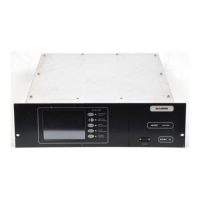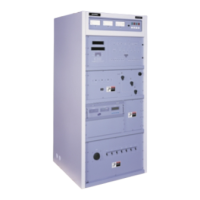LOCAL: Indicates the transmitter will not accept remote com-
mand inputs. This line will be asserted low when the transmitter
is in the LOCAL mode.
VSWR FOLDBACK ACTIVE: Indicates antenna VSWR has
caused the transmitter to reduce its output power by some amount.
It will be asserted low while the foldback is active.
VSWR FAULT: Indicates the modules have not come up to
power at the end of three seconds after a VSWR overload set
point has been exceeded. Note that active fold-back will inhibit
VSWR overload detection. Upon detection of an overload, this
line will be asserted low.
MONITOR FAULT: Indicates the monitor has failed and all calcu-
lated readings may be incorrect. Upon monitor failure, the line will
be asserted low.
CONTROL FAULT: Indicates one of the cabinet controllers has
failed and not responding to requests for data from the monitor
bus. Upon failure, the line will be asserted low.
EXTERNAL INTERLOCK: Indicates the status of the external
interlock. If the interlock is open, a low will be asserted.
PHASE LOSS: Indicates status of the internal AC phase loss
detector. If detector senses loss of one of the three phase power
lines, PHASE LOSS will be asserted low.
EXCITER MUTE: Indicates that some function has muted the
exciter. Asserted low for mute.
EXCITER FAULT: Indicates exciter fault directly in single ex-
citer configuration. Indicates exciter fault from optional exciter
switcher if used. Asserted low for fault.
SUPPLY FAULT: Indicates one or more of the 50 volt power
supplies has failed. Asserted low upon fault.
MODULE FAULT: Indicates one or more of the cabinet RF
modules has faulted off. Asserted low upon fault.
AIR LOSS: Indicates one or more of the cabinets has lost air supply.
Asserted low upon loss of cabinet pressure.
DOOR INTERLOCK: Asserted low if oneor more of the cabinet
doors is open.
SPARE FAULT: Not used at this time.
2.11.4.3 J33: Analog Outputs
The analog outputs on the I/O panel provide both calibrated and
un-calibratedreadingsfor some functions.Thecalibratedoutputs
are a function of the monitoring system. The raw outputs come
directly from the RF peak detectors. Each output is buffered by
a voltage follower, with a 1 kOhm resistor in series with the
signal, before leaving the main controller board.
J33 CALIBRATED OUTPUTS RANGE:
1 VIS FORWARD POWER
0-3.0VOLTS=0-100%
2VISVSWR
0 - 2.0 VOLTS = 1.0 - 2.0 VSWR
3 AURAL FORWARD POWER
0-3.0VOLTS=0-100%
4 AURAL VSWR
1 - 2.0 VOLTS = 1.0 - 2.0 VSWR
The above four selections follow the A/D edit function (part
of user setup).
RAW UN-CALIBRATED OUTPUTS:
5 REJECT LOAD 1 POWER
0-2.5 volts = 0 to max reject power
6 REJECT LOAD 2 POWER
0-2.5 volts = 0 to max reject power
7 REJECT LOAD 3 POWER
0-2.5 volts = 0 to max reject power
8 VISUAL FORWARD POWER
0-2.5 volts = 0-100% power
1
0-1.8 volts = 0-100% power
2
9 AURAL FORWARD POWER
0-2.5 volts = 0-100% power
1
0-0.8 volts = 0-100% power
2
10 VISUAL REFLECTED POWER
0-2.5 volts = 1.0-3.0 VSWR
1
0-1.8 volts = 1.0-3.0 VSWR
2
11 AURAL REFLECTED POWER
0-2.5 volts = 1.0-3.0 VSWR
1
0-1.8 volts = 1.0-3.0 VSWR
2
12-19,37 NC
20-36 ANALOG GROUND SIDE
OF 1-11
1
For High Power Transmitters (>HT10)
2
For Low Power Transmitters (<=HT10)
2.11.4.4 Optional Remote Status
The optional exciter switcher supplies an output showing which
exciter is selected. Each line is asserted low to indicate the
corresponding condition.
These drivers have the same ratings as the other status outputs.
J34, pin 9 is the current source for the opto couplers in the
connectedequipment,and issuppliedthevoltageselectedbyJ21.
J34 OPTIONAL STATUS
(from J-17 MAIN CONTROLLER):
1 EXCITER A SELECTED
2 EXCITER B SELECTED
3 MANUAL SELECTED
4 FUTURE OPTION
5 FUTURE OPTION
6 GROUND
7 GROUND
8 GROUND
9 VOLTAGE SOURCE
for Opto Couplers
(Connected to J32-19 & 37)
Refer to drawing 839-7900-143.
Optional Status Functions:
EXCITER A SELECTED: Indicates exciter “A” is selected.
EXCITER B SELECTED: Indicates exciter “B” is selected.
MANUAL SELECTED: Indicates the switcher is in the manual
mode.
2-6 888-2365-001 Rev. C: 8-24-2000
WARNING: Disconnect primary power prior to servicing.
